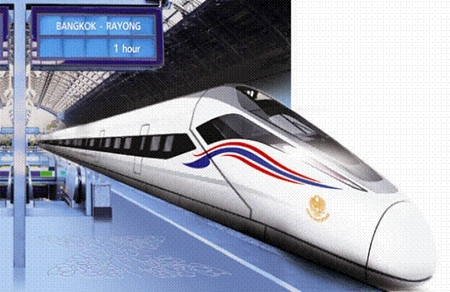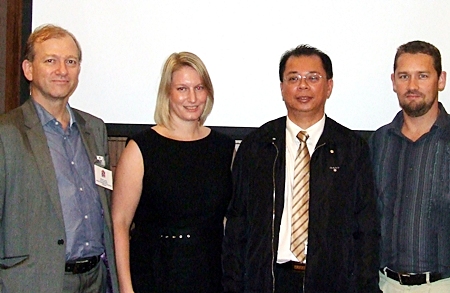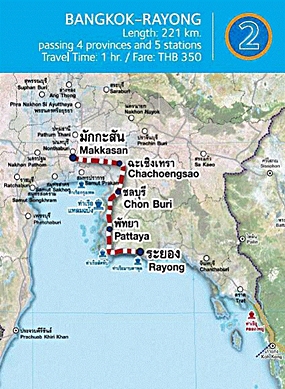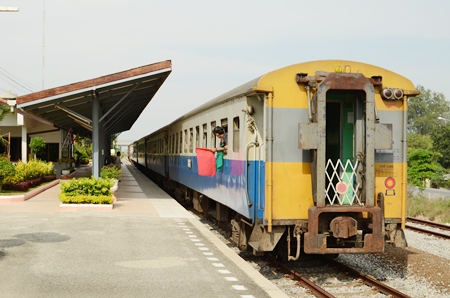Residents and visitors to Pattaya and the Eastern Seaboard hoping to see the development of a high-speed rail network cut travelling times to the capital Bangkok to less than one hour might, proverbially speaking, have to wait a while longer to get their tickets punched according to the government’s Dr. Chula Sukmanop PhD, Inspector General for the Ministry of Transport.
Speaking at a special meeting hosted recently by the British Chamber of Commerce and Austcham at the Amari Orchid Resort and Tower, Dr. Chula stated that high level discussions on the development of the rail network in Thailand are currently only at the preliminary stages and any decision on developing a high-speed rail infrastructure (HSR) would also have to include Thailand’s ASEAN neighbours as part of the region’s ultimate goal of having a standardized, interconnecting rail system.

Dr. Chula did however concede that vast improvement and expansion needs to be carried out to Thailand’s current 4,350km of rail track to bring it up to the standard required to open the preliminary stages of the ASEAN rail network by 2015.
“The rail system in the country definitely needs to be improved to make it more efficient and consumer friendly,” said the Doctor.
New diesel locomotives have already been purchased and a double-track project is currently ongoing to link Chachoengsao and Laem Chabang Port in an effort to take a large percentage of freight off the Eastern Seaboard’s overstretched road system and onto the new rail line. By current estimates over 75% of Thailand’s freight currently moves by road with less than 25% by rail. The government hopes to increase the locomotive transported goods by up to 50% within the next 4 years. The double track to Laem Chabang is expected to be completed by the end of first quarter 2012.
 From left: Simon Landy, Executive Chairman of Colliers International (Thailand) and Vice Chairman of the BCCT, Abigail Evans, Executive Transport Planner for Meinhardt (Thailand), Dr. Chula Sukmanop PhD, Inspector General for the Ministry of Transport and Mark Carroll, Executive Director of Austcham, pose for a photo at the conclusion of the meeting held at the Amari Orchid Resort & Tower, Pattaya.
From left: Simon Landy, Executive Chairman of Colliers International (Thailand) and Vice Chairman of the BCCT, Abigail Evans, Executive Transport Planner for Meinhardt (Thailand), Dr. Chula Sukmanop PhD, Inspector General for the Ministry of Transport and Mark Carroll, Executive Director of Austcham, pose for a photo at the conclusion of the meeting held at the Amari Orchid Resort & Tower, Pattaya.
For immediate improvements to the local passenger network with the development of HSR the Doctor was less optimistic. Although the Bangkok – Rayong/Chantaburi route, along with four others, falls under the umbrella of those with the most promise for high economic return on investment (ROI), currently the government and State Railways of Thailand are concentrating their resources on upgrading and maintaining the existing 4,000km of rail network.

“Any possible high-speed rail link would need to be funded by private enterprise through Public Private Partnerships (PPPs) or in a joint venture with other countries,” said Dr. Sukmanop.
On this note he advised that Thailand is currently in negotiations with Japanese experts to conduct a feasibility study into two high speed rail lines in the Kingdom; one from Bangkok to Chiang Mai and another from Bangkok to Rayong.
At this stage however the government seems very keen on developing a joint venture with China to build a high speed rail network in the country. With the Chinese already negotiating to build a line through Laos to the Thai border, it would seem logical that a link connecting Kunming in China to Bangkok, the Andaman sea ports and ultimately Singapore would be something that Thailand’s northern neighbours would see as most beneficial from an economic standpoint.
“The Chinese want freight access to the Andaman Sea,” said Dr. Sukmanop.
Unfortunately negotiations with the Chinese have stalled for the time being due to corruption charges being leveled at top transport ministers in that country. The next stage therefore is to wait for the results of the feasibility study, expected early next year, with a view to deciding whether contracts for developing at least part of the HSR network should be granted to Japanese private enterprise instead.
 In the proposals, Pattaya railway station would be redeveloped into a transportation hub with links to all parts of the city.
In the proposals, Pattaya railway station would be redeveloped into a transportation hub with links to all parts of the city.
Another factor to consider is the high economic cost of the current flooding in many provinces of Thailand which will result in a considerable expenditure to repair damaged road and rail networks. The bottom line being that the HSR proposal could be pushed further onto the back-burner, at least in the short term.
Co-chairing the presentation with Dr. Sukmanop was Abigail Evans, the Executive Transport Planner for Meinhardt (Thailand).
Abigail reiterated Dr. Sukmanop’s view that a dedicated high speed rail link to Pattaya was unlikely anytime soon, however she opined that an extension of the current airport link from Makkasan(Bangkok) – Suvarnabhumi to the Eastern Seaboard could be equally effective in its place.
“The existing passenger rail link between Pattaya and Bangkok is to all intents and purposes obsolete,” said Abigail. “There is only one train a day going in each direction and the one from Bangkok leaves at 6.55 a.m., takes almost 4 hours travelling time and only has third class facilities available. Clearly it is currently much more convenient and in many respects cheaper to take cars and buses to Bangkok and vice versa,” she added.
The much hyped Makkasan Air Terminal in Bangkok has become something of an embarrassment to the Thai government since it opened, as simply getting to and from it has proved problematic for passengers and the cost of an express ticket on top provides little if any financial advantage over taking a taxi to the airport. Consequently the state of the art facility is rapidly turning into a white elephant with only a handful of passengers using the express line each day.
A connection with commuters from the Eastern Seaboard however could see Makkasan transformed into a mega transport and commercial hub with links to the domestic terminal at Don Muang and Bangkok’s MRT lines thrown in.
Equally, Pattaya’s existing railway station on the eastern side of Sukhumvit Road could be developed in a similar fashion with improved transport and shuttle services to the center of town and the beach and shopping areas. Interestingly, rumours have circulated that investors are already starting to buy up land around Pattaya’s railway station, possibly indicating that something could be in the pipeline in the not too distant future.
“The Pattaya railway station will not be moved with either HSR or an airport link extension,” commented Agibail. “Instead commercial operators would be encouraged to move there and the transport infrastructure would be improved.”
She added that current government thinking favoured the extension of the airport link over a new high speed rail line to the Eastern Seaboard as it would be more economical to build and quicker to implement, but on the downside it would be limited to passenger traffic only with a lower capacity and no freight carrying capability.
The high speed rail line on the other hand could effectively handle up to 30,000 passengers a day between Bangkok and Rayong with a 1 hour travelling time from a proposed starting point at the New City Terminal in Bang Sue.
With Pattaya developing its attractions rapidly from both a tourist and commercial standpoint, the relatively recent opening of Central Beach shopping mall and the new King Power duty free store being two prime examples, it seems logical that the city will in time develop a much improved rail link to the capital with many Bangkokians also using the service, either for weekend shopping trips or to visit their holiday homes and condos by the sea. Cutting the travelling times for commuters from Bangkok could therefore prove very beneficial to Pattaya’s property developers who would also have a larger target market to aim at.
When all this comes to fruition is however more of a mute point with timescales of anything up to 15 years being aired and environmental impacts also to be taken into consideration. It seems therefore, that despite the obvious benefits to the city and its residents, Pattaya might be looking a little longer down the line until its train finally comes in.
(by Martin Bilsborrow / Pattaya Mail)




